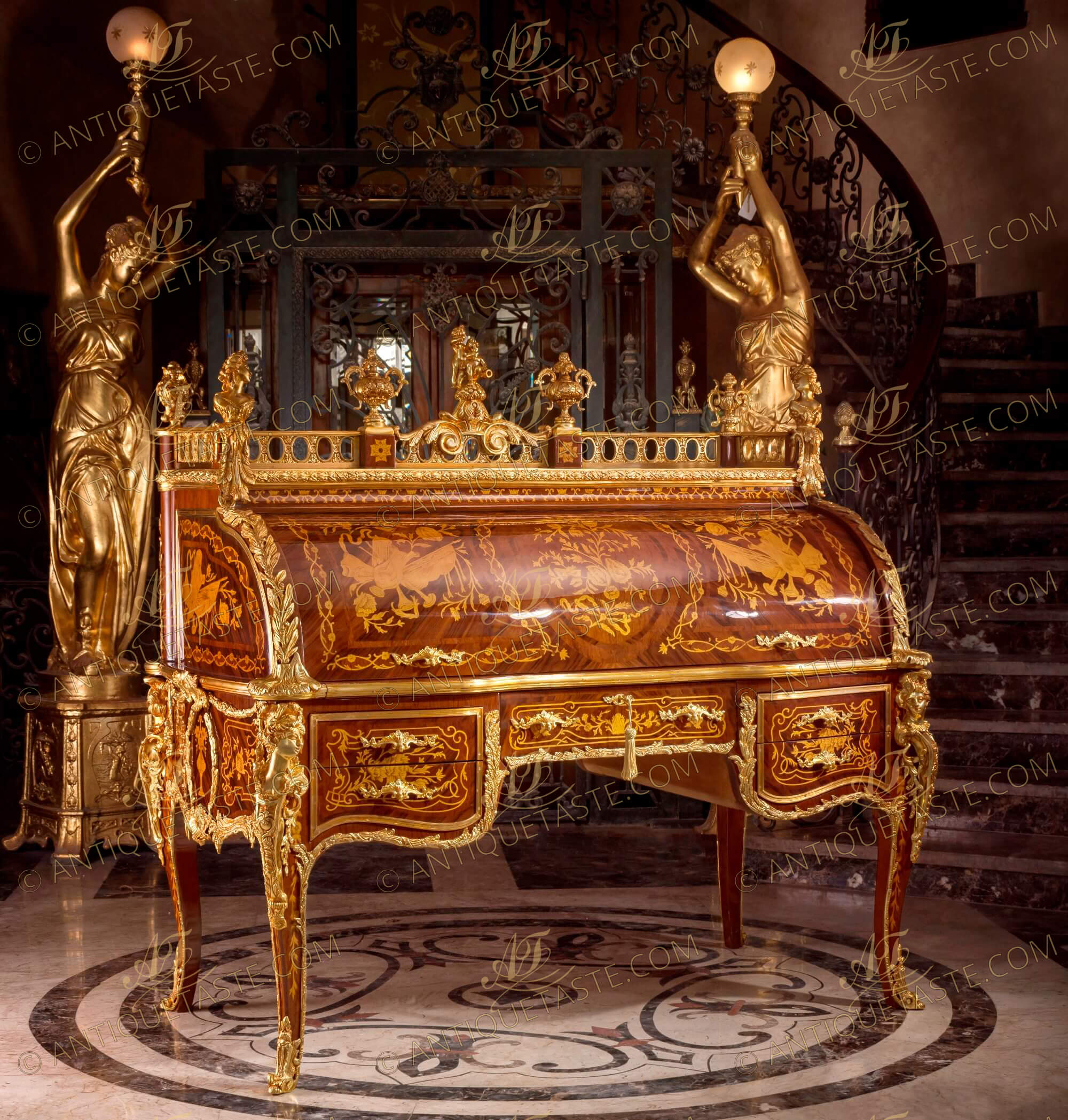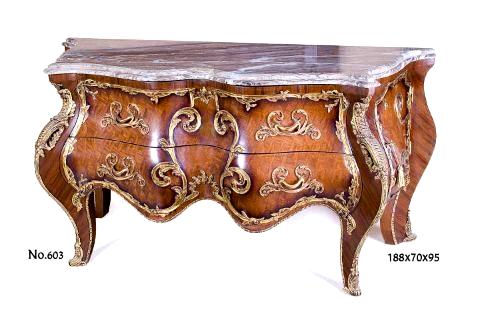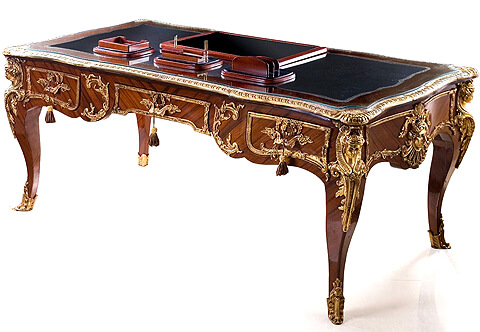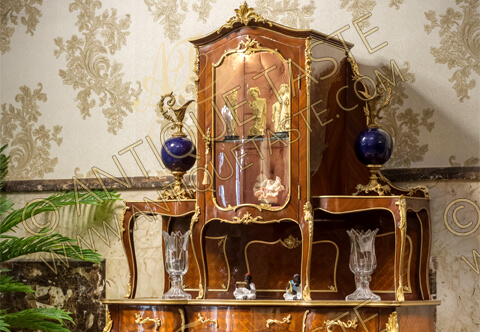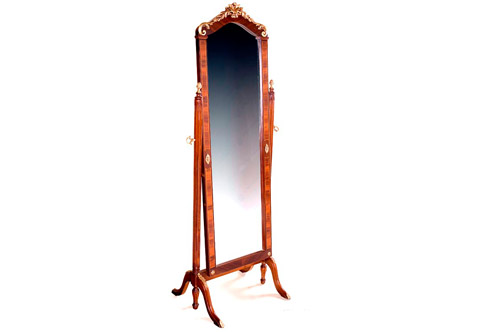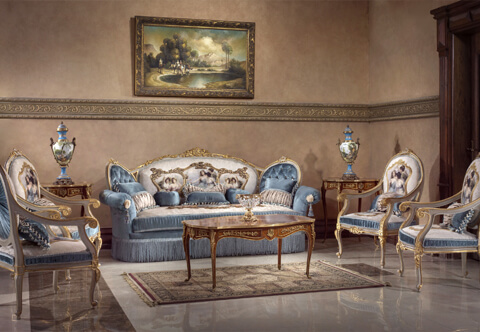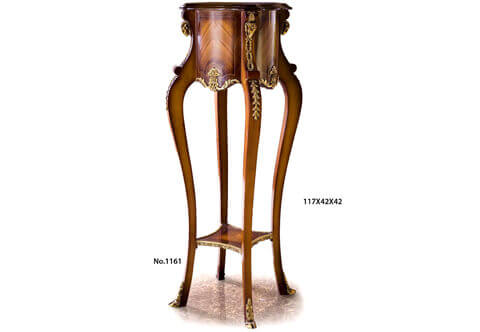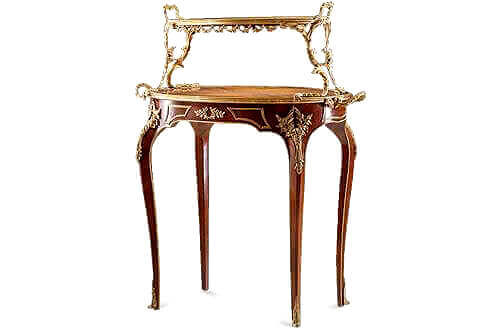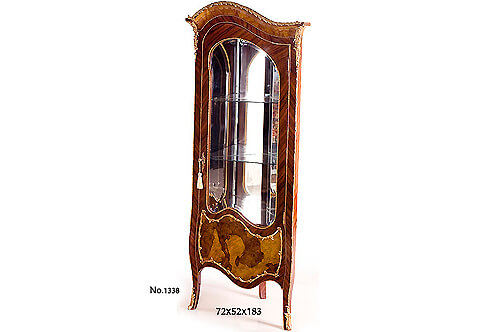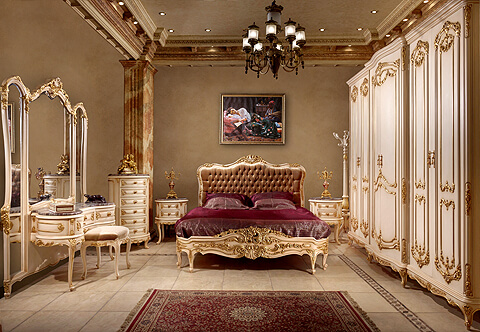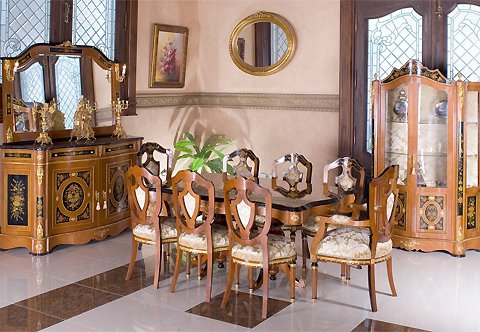Le Bureau du Roi | King Louis XV's Royal Grand Roll-Top Secretary Desk after the model by Jean-François Oeben and Jean-Henri Riesener
Ref#D-B93Roi | Description
Our elaborate copy of the marvelous Le Bureau Du Roi (Secrétaire Cylindre de Louis XV), "King Louis XV Roll-Top Secretary Desk", the most celebrated piece of eighteenth-century's French furniture after the model by Jean-François Oeben and Jean-Henri Riesener circa 1769;
The fine piece is manufactured of the solid beech wood and covered with intricate marquetry and veneer inlays of a wide variety of fine woods and fine chiseled gilt ormolu mounts,
The open ormolu pierced gallery top surmounted with ormolu urns of prosperity, ormolu female busts with acanthus foliate movements and two celebrating putti on acorn and scroll-works to the center. The rectangular top gallery is bordered with beaded leaf and dart on cyma reversa ormolu band surrounding marquetry works,
The beautiful cylinder roll up inlaid with striking sans traverse veneer inlays centered with a flower bouquet flanked to both sides with marquetry of musical instruments and trophies all within a foliate scrolled veneer entwined filet, and two foliate ormolu handles, opens to reveal a marquetry and veneer inlaid substantial pull out sliding writing surface, smaller drawers and chambers of medium sizes. The curved sides of the desk are adorned with ormolu laurel leaves terminating with clasps and inlaid with marquetry patterns of foliate royal cartouche to the internal parts, the outer sides has the same marquetry works of the cylinder front
At the scalloped shaped frieze below is a central drawer with ormolu keyhole escutcheon flanked with two smaller drawers to each side framed with brass filets, all have foliate ormolu handles, foliate marquetry ornamentations and scrolled veneer fillets, bordered below with highly detailed foliate ormolu filets in a satin and burnish finish extending to the legs,
At each corner are large and impressive ormolu mounts of richly chased royal male and female, fleur de lis and scroll works, repeated to back. The sides are professionally ornamented with highly detailed ormolu filets in a satin and burnish finish representing a central issuing festoons with knotted ribbon pendants to the sides, curving laurel bay leaf to the bottom centered with marquetry and acanthus marquetry, connected to a central shell issuing foliate filets topped with foliate marquetry and extending to internal side of the legs,
The back has the same marquetry decorations of the front, the top part is centered with a large ormolu plaque of playful putti. The desk is raised on cabriole legs inlaid with foliate marquetry inlays and terminating with turned acanthus ormolu cast sabots.
D-B93Roi
H:160 x W:165 x D:85cm
Louis XV Style | Jean-François Oeben | Jean-Henri Riesener
The Bureau du Roi History
This desk is considered the most celebrated piece of eighteenth-century French furniture, the 'bureau du roi', or roll-top desk (the first of its kind) now at Versailles, which was made for Louis XV by Jean-François Oeben (1721-1763) and Jean-Henri Riesener (1734-1806) and delivered in 1769.
It was made for the 4th Marquess of Hertford, probably by Carl Dreschler, in Paris. In the 1850s the 4th Marquess of Hertford was a friend of Napoleon III and the Empress Eugénie and is likely to have seen the original desk, either in the grand salon of the Tuileries or, later, in Eugénie's study at the palace of Saint-Cloud to where it was moved by 1855. The maker has copied the desk as it was after the alterations of 1794, when the original interlaced Ls of Louis XV were replaced with biscuit porcelain Sèvres plaques and elements of the marquetry decoration were changed.
Lord Hertford's copy may date from the 1850s and is believed to have cost him £3000, an enormous amount of money. He commissioned other copies of celebrated pieces of French eighteenth-century furniture at this time, made in both France and England, but this and a copy of the bureau of the Elector of Bavaria (museum number F461) are the only two in the Wallace Collection. His copy of the bureau du roi was the first of a number of copies that were produced from the 1870s by leading cabinet-makers in Paris, including Henri Dasson (exhibited at the Exposition Universelle in 1878), J-E. Zweiner, Alfred Beurdeley, J-H. Jansen and François Linke.
Jean-François Oeben
Jean-François Oeben (born c. 1715, Germany—died January 21, 1763, Paris, France), influential French cabinetmaker noted for his outstanding marquetry and for his ingenious mechanical devices.
Oeben came to France at an unknown date and in 1751 entered the workshop of Charles-Joseph Boulle, a son of the famous cabinetmaker André-Charles Boulle, in the Louvre. He was soon patronized by the king’s mistress Mme de Pompadour and in 1754 was appointed ébéniste du roi (“Royal Cabinetmaker”). Much of his work was done for the royal household. His royal warrant gave him the privilege of a workshop in the Gobelins factory, although he later moved to the Arsenal. His masterpiece is the bureau du roi, a desk for the king that he began in 1760 and was working on at the time of his death; it was finished by his younger associate, Jean-Henri Riesener, who also married his widow.[Britannica]
Jean-Henri Riesener
Jean-Henri Riesener, (born July 4.1734, Gladbeck, Münster [Germany]—died Jan. 6.1806, Paris, France), the best-known cabinetmaker in France during the reign of Louis XVI. Riesener was the son of an usher in the law courts of the elector of Cologne. After moving to Paris he joined the workshop of Jean-François Oeben in 1754, and, when Oeben died in 1763, Riesener was put in charge of the workshop and later married his master’s widow.
He made his name by completing and delivering to Louis XV the famous bureau du roi (“king’s desk”), begun by Oeben. In 1774 he was made royal cabinetmaker and from then onward was the regular supplier of furniture to the queen, Marie-Antoinette. Although he was one of the most versatile of cabinetmakers, his services were in little demand during the French Revolutionary period because of his political status.
Riesener used both European and exotic woods, with a preference for mahogany; he occasionally used lacquer and mother-of-pearl to enrich the surfaces of his works. His finished style was pure Louis xvi, with its rectilinear side view and harmonious ornamentation.

